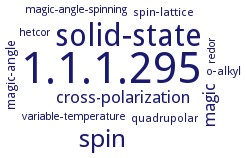1.1.1.295: momilactone-A synthase
This is an abbreviated version!
For detailed information about momilactone-A synthase, go to the full flat file.

Word Map on EC 1.1.1.295 
-
1.1.1.295
-
solid-state
-
spin
-
magic
-
cross-polarization
-
magic-angle
-
spin-lattice
-
quadrupolar
-
o-alkyl
-
magic-angle-spinning
-
redor
-
hetcor
-
variable-temperature
- 1.1.1.295
-
solid-state
-
spin
-
magic
-
cross-polarization
-
magic-angle
-
spin-lattice
-
quadrupolar
-
o-alkyl
-
magic-angle-spinning
-
redor
-
hetcor
-
variable-temperature
Reaction
Synonyms
3beta-hydroxy-9beta-primara-7,15-dien-19,6beta-olide dehydrogenase, AK103462 protein, CpMAS, momilactone A synthase, MS1, MS2, Os04g0179200, OsMAS, OsMAS2
ECTree
Advanced search results
General Information
General Information on EC 1.1.1.295 - momilactone-A synthase
Please wait a moment until all data is loaded. This message will disappear when all data is loaded.
evolution
metabolism
early regulation of genes putatively related to nematode damage-associated molecular pattern recognition (e.g. wall-associated receptor kinases), signalling (nucleotide-binding, leucine-rich repeat (NLRs)), pathogenesis-related (PR) genes (PR1, PR10a), defence-related genes (NB-ARC domain-containing genes), as well as a large number of genes involved in secondary metabolites including diterpenoid biosynthesis (CPS2, OsKSL4, OsKSL10, Oscyp71Z2, oryzalexin synthase, and momilactone A synthase) is observed in rice Meloidogyne graminicola-resistant mutant line-9. After the nematode juveniles penetrate the roots of line-9, early recognition of invading nematodes triggers plant immune responses mediated by phytoalexins, and other defence proteins such as PR proteins inhibit nematode growth and reproduction. Mechanisms underlying plant-nematode resistance in rice, overview. Momilactone A is one of several phytoalexins also such as oryzalexin D, oryzalexin E, and phytocassane being part of the secondary metabolite biosynthesis pathways activated in defense. The enzyme is involved in diterpenoid biosynthesis
physiological function
isoform MS2 more efficiently catalyzes the final oxidation to produce momilactone A than isoform MS1
-
molecular architecture of the momilactone biosynthetic genes and evolutionary relationships with other momilactone-producing plants. Both cultivated and wild grass species of Oryza and Echinochloa crus-galli (barnyard grass) produce momilactones using a biosynthetic gene cluster (BGC) in their genomes. The bryophyte Calohypnum plumiforme (formerly Hypnum plumaeforme) also produces momilactones, and the bifunctional diterpene cyclase gene CpDTC1/HpDTC1, which is responsible for the production of the diterpene framework. While the gene cluster in Calohypnum plumiforme is functionally similar to that in rice and barnyard grass, it is likely a product of convergent evolution. Echinochloa crus-galli (barnyard grass) has been shown to possess one copy of the momilactone gene cluster in its genome. Thus, all of the momilactone-producing higher plants reported thus far appear to have a family-conserved BGC in their genomes. Evolution of momilactone gene clusters in plants, overview
evolution
molecular architecture of the momilactone biosynthetic genes and evolutionary relationships with other momilactone-producing plants. Both cultivated and wild grass species of Oryza and Echinochloa crus-galli (barnyard grass) produce momilactones using a biosynthetic gene cluster (BGC) in their genomes. The bryophyte Calohypnum plumiforme (formerly Hypnum plumaeforme) also produces momilactones, and the bifunctional diterpene cyclase gene CpDTC1/HpDTC1, which is responsible for the production of the diterpene framework. While the gene cluster in Calohypnum plumiforme is functionally similar to that in rice and barnyard grass, it is likely a product of convergent evolution. Echinochloa crus-galli (barnyard grass) has been shown to possess one copy of the momilactone gene cluster in its genome. Thus, all of the momilactone-producing higher plants reported thus far appear to have a family-conserved BGC in their genomes. Evolution of momilactone gene clusters in plants, overview
evolution
molecular architecture of the momilactone biosynthetic genes in the moss genome and their evolutionary relationships with other momilactone-producing plants. Both cultivated and wild grass species of Oryza and Echinochloa crus-galli (barnyard grass) produce momilactones using a biosynthetic gene cluster (BGC) in their genomes. The bryophyte Calohypnum plumiforme (formerly Hypnum plumaeforme) also produces momilactones, and the bifunctional diterpene cyclase gene CpDTC1/HpDTC1, which is responsible for the production of the diterpene framework. While the gene cluster in Calohypnum plumiforme is functionally similar to that in rice and barnyard grass, it is likely a product of convergent evolution. Echinochloa crus-galli (barnyard grass) has been shown to possess one copy of the momilactone gene cluster in its genome. Thus, all of the momilactone-producing higher plants reported thus far appear to have a family-conserved BGC in their genomes. Evolution of momilactone gene clusters in plants, overview


 results (
results ( results (
results ( top
top






